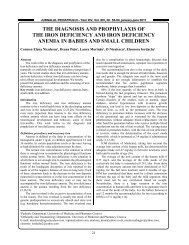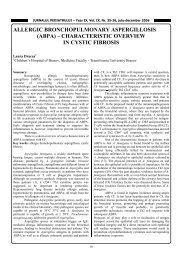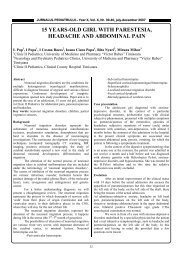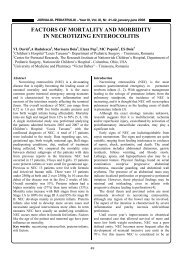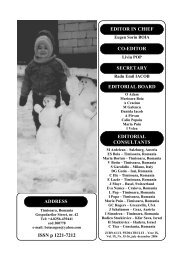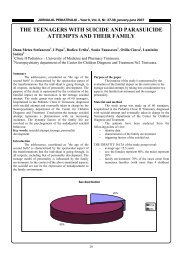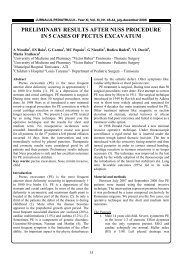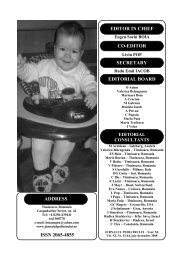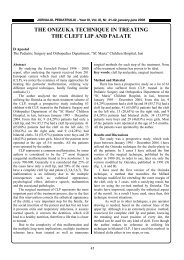congenital lobar emphysema (cle) radiologic and imagistic (ct)
congenital lobar emphysema (cle) radiologic and imagistic (ct)
congenital lobar emphysema (cle) radiologic and imagistic (ct)
You also want an ePaper? Increase the reach of your titles
YUMPU automatically turns print PDFs into web optimized ePapers that Google loves.
JURNALUL PEDIATRULUI – Year XIII, Vol. XIII, Nr. 51-52, july-december 2010<br />
CONGENITAL LOBAR EMPHYSEMA (CLE)<br />
RADIOLOGIC AND IMAGISTIC (CT) DIAGNOSTIC<br />
M Popescu 1 , Valeria Dehelean 1 , Delia Mihailov 1<br />
1 Emergency Children’s Hospital”Louis Ţurcanu”, Timişoara<br />
Abstra<strong>ct</strong><br />
A new born child, age: one month, sex: masculin,<br />
with acute respiratory distress syndrome, perioronasal<br />
cyanosis <strong>and</strong> hypoxemia has been diagnosed (<strong>radiologic</strong>al<br />
<strong>and</strong> imagical – CT) with <strong>congenital</strong> <strong>lobar</strong> <strong>emphysema</strong> (CLE<br />
) at the level of the right superior lobe.<br />
One month after, the new born child has been<br />
diagnosed with the aforesaid syndrome, <strong>and</strong>, now two<br />
months old, he has been subje<strong>ct</strong>ed to a surgical intervention<br />
consisting in lobe<strong>ct</strong>omy at the level of the right superior<br />
lobe.<br />
His postsurgical evolution has proved satisfa<strong>ct</strong>ory<br />
with pulmonary reexpansion.<br />
Key words: <strong>congenital</strong> phatology, pneumophatology,<br />
<strong>congenital</strong> <strong>lobar</strong> <strong>emphysema</strong><br />
Introdu<strong>ct</strong>ion<br />
Congenital malformations of the lung are rare <strong>and</strong><br />
vary widely in their presentation <strong>and</strong> severity(4).<br />
Congenital <strong>lobar</strong> Emphysema (CLE) is infrequent<br />
<strong>and</strong> usually present at birth(8).<br />
The superior lobes are affe<strong>ct</strong>ed (5) <strong>and</strong> a single lobe<br />
usually is involved; however, patients can show multiple<br />
<strong>lobar</strong> involement (8). The rates of occurrence are: left upper<br />
lobe – 41%, right middle lobe – 34%; right upper lobe -<br />
21%(5,8).<br />
Frequently, cartilage plates in the bronchi are absent<br />
at the level where cartilage is expe<strong>ct</strong>ed (5,8). The<br />
abnormality is related to intrinsic bronchial narrowing. In<br />
these cases, there is weakened or absent bronchial cartilage,<br />
so that there is inspiratory air entry but collapse of the<br />
narrow bronchial lumen during expiration. This bronchial<br />
defe<strong>ct</strong> result in <strong>lobar</strong> air trapping (7,8).<br />
Pulmonary arteries are normal in patients with CLE<br />
(8). Angiography shows slow <strong>and</strong> poor arterial filling (5).<br />
Hipoxemia (in severely affe<strong>ct</strong>ed pacients) may occur<br />
(8).<br />
CASE PRESENTATION<br />
Anamnesis <strong>and</strong> clinic findings:<br />
1 (one) month new – born child, male has been<br />
brought to Louis Turcanu Children Emergency Hospital<br />
from Timisoara on April 21, 2009 <strong>and</strong> has been hospitalized<br />
in the Pediatric Department.<br />
Upon hospitalization, he presented a severe general state,<br />
perioronasal cyanosis, aerated secretions at the mouth level,<br />
mixed dispneea, continuous exhausting cough <strong>and</strong><br />
disseminated subcrepitant rhonchi.<br />
Paraclinic findings:<br />
- Gases into the blood: ph=7,431; pCO2 (carbon<br />
dioxide pressure) = 44,2mmHg; reduced pO2<br />
(oxygen pressure) = 38,1mmHg (normal: pO2<br />
= 75,0 – 100,0mmHg).<br />
- Blood exam: HGB = 11,5g/dL (normal: 12,0 –<br />
16,5g/dL), lymphocytes (11,25x10 3 /uL),<br />
monocytes (1,87x10 3 /uL).<br />
- Cardiac echograhic examination (conclusion):<br />
normal stru<strong>ct</strong>ured cord, moved to the left <strong>and</strong><br />
down side, inclusive the aortic arch is moved 2<br />
(two) inter – rib space down.<br />
- ECG: RS – regulated, 160 beats per minute,<br />
QRS + 60 0 axis, left branch minor block, the<br />
rest presents a normal ele<strong>ct</strong>ric path.<br />
Radiological <strong>and</strong> imagical aspe<strong>ct</strong>s:<br />
St<strong>and</strong>ard Radiography:<br />
Marked hyperaeration <strong>and</strong> overdistention of the right<br />
upper lobe with mediastinal shift to the left. Aer ation <strong>and</strong><br />
left lung redu<strong>ct</strong>ion (hypoventilated by means of<br />
compression) (Fig. 1, Fig. 2).<br />
Computer Tomography:<br />
Pronounced distention of the right superior lobe with<br />
<strong>lobar</strong> hypovascularisation in comparison with the left<br />
superior lobe. The hyperinflated LSD dire<strong>ct</strong>s the medistine<br />
stru<strong>ct</strong>ures towards the left side, having a compressive effe<strong>ct</strong><br />
on the LMD <strong>and</strong> LIED (Fig. 3, Fig. 4).<br />
Virtual Bronchoscopy:<br />
At the level of the right superior <strong>lobar</strong> bronchus, an<br />
anterior <strong>and</strong> inferior oriented tra<strong>ct</strong> can be noticed, with a<br />
permeable lumen extending up to the bifurcation level,<br />
where, due to the extremely reduced dimensions of the<br />
segmentary bronchi diameter, the endobronchial navigation<br />
can no longer continue. The diameter of the right superior<br />
<strong>lobar</strong> bronchus has diminished in comparison with the left<br />
superior <strong>lobar</strong> bronchus (1,4 mm at emergency, in<br />
comparison with a 1,8 mm diameter).<br />
47
JURNALUL PEDIATRULUI – Year XIII, Vol. XIII, Nr. 51-52, july-december 2010<br />
Fig. 1 Postero-anterior view.<br />
Marked hyperaeration <strong>and</strong> overdistention<br />
<strong>and</strong> mediastinal shift to the left.<br />
Fig. 2 Lateral view. Marked<br />
hyperaeration <strong>and</strong> overdistention of the<br />
retrosteranal space.<br />
Fig. 3 Uper thorax se<strong>ct</strong>ioon. Marked<br />
hyperaeration <strong>and</strong> overdistention of the right<br />
superior pulmonar lobe with mediastinal shift<br />
<strong>and</strong> compresion with hypoventilation of the<br />
left superior pulmonar lobe.<br />
Fig.4 Midle thorax. Marked hyperaeration <strong>and</strong><br />
overdistention of the right superior pulmonar<br />
lobe with mediastinal shift <strong>and</strong> compresion<br />
with hypoventilation of the left superior<br />
pulmonar lobe.<br />
Discussions<br />
The <strong>congenital</strong> <strong>lobar</strong> <strong>emphysema</strong> can be dete<strong>ct</strong>ed<br />
even from the prenatal period in the presence of a<br />
hyperechogenic pulmonary zone (2). The echographic<br />
semiology is not very <strong>cle</strong>ar, <strong>and</strong> that 's why, we shall resort<br />
to other medical imaging techniques, such as prenatal<br />
nu<strong>cle</strong>ar MRI <strong>and</strong> postnatal tomodensiometry (CT)(2).<br />
As regards our medical investigation, the diagnosis<br />
established by us has been revealed by the postnatal<br />
tomodensiometry (CT).<br />
The symptomatic form of the <strong>congenital</strong> <strong>lobar</strong><br />
<strong>emphysema</strong> (CLE) must be immediately dete<strong>ct</strong>ed <strong>and</strong><br />
operated because the subsequent diagnosis shall be<br />
conditioned by the patient 's age at the moment when the<br />
surgical intervention is performed (3).<br />
48
JURNALUL PEDIATRULUI – Year XIII, Vol. XIII, Nr. 51-52, july-december 2010<br />
The surgical intervention can be avoided only in case<br />
of incipient forms of the syndrome, with negligible<br />
distension <strong>and</strong> without apparent symptomatology (3,6).<br />
Unfortunately, the patient into question has been<br />
diagnosed with a quite serious distension <strong>and</strong> apparent<br />
symptomatology so, in this case, the surgical intervention<br />
was absolutely compulsory. The surgery (right superior<br />
lobe<strong>ct</strong>omy) has been performed on May 18, 2009, more<br />
specifically, one month after the diagnosis has been<br />
established. The postsurgical evolution has proved<br />
satisfa<strong>ct</strong>ory with the reexpansion of the left pulmonary <strong>and</strong><br />
the segments left from the left lung (Fig. 5).<br />
Fig. 5 Postoperative aspe<strong>ct</strong>. Re-expantion of<br />
the midle <strong>and</strong> inferior lobe of the right lung<br />
<strong>and</strong>re-expantion of the left lung.<br />
As regard to the differential diagnosis (1) analysed<br />
by us after the st<strong>and</strong>ard cardiopulmonary radiography has<br />
been performed, the possibility of the left pulmonary<br />
hypoplasia with right pulmonary hyperinflation has been<br />
brought into discussion <strong>and</strong> analyzed.<br />
Conclusions<br />
1. The cardiopulmonary <strong>radiologic</strong> exam (st<strong>and</strong>ard<br />
radiography: front <strong>and</strong> profile) <strong>and</strong> the <strong>imagistic</strong> exam (CT<br />
or MRI) represents diagnosis elements in the cases of<br />
<strong>congenital</strong> <strong>lobar</strong> <strong>emphysema</strong> (CLE).<br />
2. The surgery (lobe<strong>ct</strong>omy) represents the treatment<br />
indicated by the apparent symptomatic forms of the<br />
<strong>congenital</strong> <strong>lobar</strong> <strong>emphysema</strong> (CLE).<br />
Bibliography:<br />
1. Gould C. Frank, Binstock J. Aaron, Ly Q. Justin,<br />
Campbell E. Scot, Bell P. Douglass; Congenital <strong>lobar</strong><br />
<strong>emphysema</strong> (CLE); 2006;<br />
2. Konan Bile R., Coste K., Blanc P., Boeuf B., Lecomte<br />
B., Labbe A., Laurichesse – Delmas H., Dechelotte P. J.,<br />
Lemery D., Gallot D.; Une étiologie rare de poumon<br />
hyperéchogène: l`emphysème lobaire géant congènital;<br />
Gynécologie obstétrique & fertilité; Elsevier, Paris,<br />
France; 2008;<br />
3. Mhiri Riadh, Chaabouni Malek, Loulou Fatma, Ben<br />
Salah Mounir, Turki Hichem, Mahfoudh Abdelmajid,<br />
Karray Abderrahmen; Nouri Abdellatif, Triki Ali;<br />
L`emphysème lobaire <strong>congenital</strong>. À propos de 8 cas;<br />
Tunisie medicale; 2003;<br />
4. Schwartz MZ, Ramach<strong>and</strong>ran P, Congenital<br />
Malformation of the Lung <strong>and</strong> Mediastinum, Journal of<br />
Pediatric Surgery, 1997;<br />
5. Silverman N. Frederic, Mediastinal Shift Secondary to<br />
Emphysema of Intrinsic Origin, Caffey`s Pediatric X-ray<br />
Diagnosis; eighth édition, 1985;<br />
6. Tournier Guy, Sardet – Frism<strong>and</strong> Anne, Baculard<br />
Armelle, Malformations broncho-pulmonaires et<br />
maladies du développement pulmonaire; Pneumologie<br />
pédiatrique; 1996;<br />
7. Weir J., l`Emphysème lobaire <strong>congenital</strong>; Atlas<br />
d`anatomie clinique – Radiologie et imagerie médicale;<br />
De Boeck, 1999;<br />
8. Wood P. Beverly; Congenital Lobar Emphysema, 2008.<br />
Correspondence to:<br />
Miron Popescu<br />
Dr. Iosfi Nemoianu Stret No 1-2<br />
300100 Timisoara,<br />
Romania<br />
49



